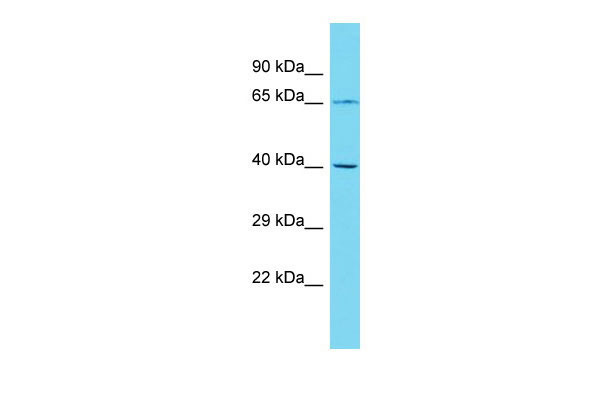DRAXIN Antibody - C-terminal region
Rabbit Polyclonal Antibody
- SPECIFICATION
- CITATIONS
- PROTOCOLS
- BACKGROUND

Application
| WB |
|---|---|
| Primary Accession | Q8NBI3 |
| Other Accession | NM_198545NP_940947 |
| Reactivity | Human, Pig, Horse, Bovine, Dog |
| Predicted | Human, Pig, Horse, Bovine, Dog |
| Host | Rabbit |
| Clonality | Polyclonal |
| Calculated MW | 36kDa |
| Gene ID | 374946 |
|---|---|
| Alias Symbol | AGPA3119, UNQ3119, neucrin |
| Other Names | Draxin {ECO:0000255|HAMAP-Rule:MF_03060}, Dorsal inhibitory axon guidance protein {ECO:0000255|HAMAP-Rule:MF_03060}, Dorsal repulsive axon guidance protein {ECO:0000255|HAMAP-Rule:MF_03060}, Neucrin, DRAXIN {ECO:0000255|HAMAP-Rule:MF_03060}, C1orf187 |
| Format | Liquid. Purified antibody supplied in 1x PBS buffer with 0.09% (w/v) sodium azide and 2% sucrose. |
| Reconstitution & Storage | Add 50 ul of distilled water. Final anti-DRAXIN antibody concentration is 1 mg/ml in PBS buffer with 2% sucrose. For longer periods of storage, store at 20°C. Avoid repeat freeze-thaw cycles. |
| Precautions | DRAXIN Antibody - C-terminal region is for research use only and not for use in diagnostic or therapeutic procedures. |
| Name | DRAXIN {ECO:0000255|HAMAP-Rule:MF_03060} |
|---|---|
| Synonyms | C1orf187 |
| Function | Chemorepulsive axon guidance protein required for the development of spinal cord and forebrain commissures. Acts as a chemorepulsive guidance protein for commissural axons during development. Able to inhibit or repel neurite outgrowth from dorsal spinal cord. Inhibits the stabilization of cytosolic beta-catenin (CTNNB1) via its interaction with LRP6, thereby acting as an antagonist of Wnt signaling pathway. |
| Cellular Location | Secreted. |

Thousands of laboratories across the world have published research that depended on the performance of antibodies from Abcepta to advance their research. Check out links to articles that cite our products in major peer-reviewed journals, organized by research category.
info@abcepta.com, and receive a free "I Love Antibodies" mug.
Provided below are standard protocols that you may find useful for product applications.
Background
Chemorepulsive axon guidance protein required for the development of spinal cord and forebrain commissures. Acts as a chemorepulsive guidance protein for commissural axons during development. Able to inhibit or repel neurite outgrowth from dorsal spinal cord. Inhibits the stabilization of cytosolic beta- catenin (CTNNB1) via its interaction with LRP6, thereby acting as an antagonist of Wnt signaling pathway.
References
Miyake A.,et al.Biochem. Biophys. Res. Commun. 390:1051-1055(2009).
Clark H.F.,et al.Genome Res. 13:2265-2270(2003).
Otsuki T.,et al.DNA Res. 12:117-126(2005).
Gregory S.G.,et al.Nature 441:315-321(2006).
Zhang Z.,et al.Protein Sci. 13:2819-2824(2004).
If you have used an Abcepta product and would like to share how it has performed, please click on the "Submit Review" button and provide the requested information. Our staff will examine and post your review and contact you if needed.
If you have any additional inquiries please email technical services at tech@abcepta.com.













 Foundational characteristics of cancer include proliferation, angiogenesis, migration, evasion of apoptosis, and cellular immortality. Find key markers for these cellular processes and antibodies to detect them.
Foundational characteristics of cancer include proliferation, angiogenesis, migration, evasion of apoptosis, and cellular immortality. Find key markers for these cellular processes and antibodies to detect them. The SUMOplot™ Analysis Program predicts and scores sumoylation sites in your protein. SUMOylation is a post-translational modification involved in various cellular processes, such as nuclear-cytosolic transport, transcriptional regulation, apoptosis, protein stability, response to stress, and progression through the cell cycle.
The SUMOplot™ Analysis Program predicts and scores sumoylation sites in your protein. SUMOylation is a post-translational modification involved in various cellular processes, such as nuclear-cytosolic transport, transcriptional regulation, apoptosis, protein stability, response to stress, and progression through the cell cycle. The Autophagy Receptor Motif Plotter predicts and scores autophagy receptor binding sites in your protein. Identifying proteins connected to this pathway is critical to understanding the role of autophagy in physiological as well as pathological processes such as development, differentiation, neurodegenerative diseases, stress, infection, and cancer.
The Autophagy Receptor Motif Plotter predicts and scores autophagy receptor binding sites in your protein. Identifying proteins connected to this pathway is critical to understanding the role of autophagy in physiological as well as pathological processes such as development, differentiation, neurodegenerative diseases, stress, infection, and cancer.


